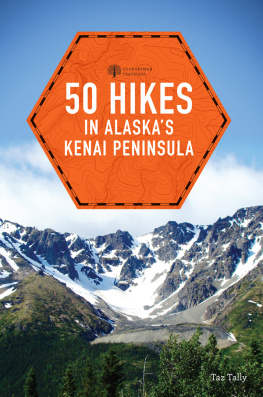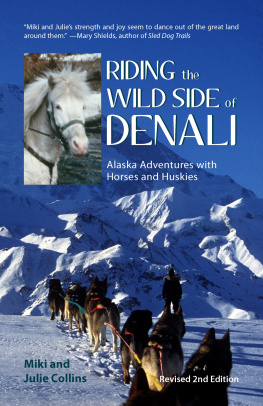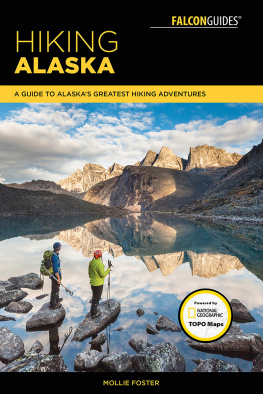

To Johnny and Beth, who are both precious family and friends

Contents

AUTUMN IN THE BROOKS RANGE IS A TAPESTRY OF COLORS AND TEXTURES
A laska encompasses a vast topography offering many fascinating wonders. From the midlatitudes of Southeast Alaska to the polar regions of the North Slope, you can sample a wider range of geographic delights than any other state in the United States or province of Canada. The southeast panhandle offers access to the largest midlatitude rain forest in the world. Alaska has more peaks over 14,000 feet, including 20,310-foot Denali, than anywhere in North America. Alaska has more alpine glaciers than anywhere else, and some of the best ocean, stream, and lake fishing on earth. Alaska offers thousands of miles of fjord coastline and hiking trails of all kinds, including uncounted miles and millions of acres of off-trail hiking across glorious alpine tundra. Visitors seeking to explore nature will find more wilderness areas, national parks, preserves, and national monuments than the rest of the U.S. combined. These wilderness areas are home to the two largest bear species (polar and brown bears), plus grizzlies, lynx, moose, caribou, sheep, multiple species of whales (including killer, humpback, gray, fin, and beluga), and sea lions.
Alaska also has a rich human history, both Native and immigrant. Mining, fishing, and logging have provided many historical and current adventures. And throughout Alaska you will find many art, music, history, and food festivals.
STATISTICS AND SUPERLATIVES
The statistics are staggering. By far the largest state, with 663,268 square miles, Alaska is more than twice the size of Texas, the next largest state. Place it over the lower 48 states and it covers a fifth of the landmass. In fact, Alaska is larger than all three of the next largest states (Texas, California, and Montana) combined and all but 18 sovereign countries. Alaska is also the state thats the farthest north, farthest west, and believe it or not, the farthest east; a segment of the Aleutian Islands, ironically named the Near Islands, is west of the 180th meridian.
Several of our 620 named glaciers and ice fields, including the Bering Glacier and the Harding Ice Field, are larger than the state of Rhode Island. One of our two-lane gravel roads, the haul road to Prudhoe Bay that leads to the Arctic Ocean, is 414 miles long and terminates 300 miles north of the Arctic Circle. Four of the roads included in this book, one on Kodiak Island and three out from Nome, are not reachable by car; you must fly or boat to them. Alaska is indeed a land of superlatives: In addition to being the largest state, Alaska has the highest peak (Denali), the most dangerous highway (the Seward Highway), the largest fish (300+-pound halibut), the biggest bears (1,300-pound Kodiak bears), and the longest coastline, which at 6,640 miles is longer than the entire Atlantic coast. We also have the most glaciers, the biggest tides, and the worlds smallest desert. What we dont have is a large population, and driving experiences here are characterized by long, delightfully empty stretches of road.
Much more of Alaska is roadless than roaded. And even highways mostly have just two lanes, including, for much of its length, the famed 1,390-mile-long Alaska Highway. Turnpikes do not exist. Most of Alaska is rural, and it has the lowest population density of any state, just 1.3 people per square mile compared to Wyomings six, which has the second lowest population density. Hugh swaths of Alaska are uninhabited wilderness, most of which is inaccessible, but some impressive sections are reachable by road. The Dalton Highway, for example, provides access to the otherwise roadless and untrammeled Gates of the Arctic National Park and Preserve and the Arctic National Wildlife Refuge. Pull-off-the-road camping is common along most roads covered in this book. If you have a self-contained rig, such as camper on the back of a pickup, your lodging opportunities and locations are nearly limitless.
One-way-in, one-way-out roads are common, leading to end-of-the-road communities such as Deadhorse, Valdez, Homer, Seward, Eagle, Circle, Manley, Teller, and Council. It is not unusual to travel great distances and see little or no development. While driving in Alaska, you will come across Native communities that use a variety of travel methods such as snowmobiles (often called snowmachines in Alaska), four-wheelers, bush planes, and dogsleds. Some communities have only twice-yearly delivery services via barge.
GETTING TO ALASKA
Most visitors fly to Alaska. Some take the Alaska Marine Highway System or arrive via cruise ship. Some drive all 1,390 miles of the Alaska Highway from Dawson Creek, British Columbia, which is itself 800 miles north of Seattle. Perhaps the most fun way to venture to Alaska is to combine traveling by the Alaska State Ferry through the Inside Passage to either Hanes Junction or Skagway, and then driving another 600 to 800 miles (depending upon where you disembark) across the Yukon Territory, Canada, and into Alaska. And yes, its a vehicle ferry, so you can bring your rig; there are no size restrictions. This combination offers plenty of opportunity for travel adventures. The marine highway section takes you along and through Alaskas varied and fascinating coastal communities, for which the ferry often provides the only regular travel access. The overland sections provide extended exposure to the grand expanses of the interiors of the Yukon, the glorious Kluane National Park and Reserve, and Alaska. For more on the Alaska Marine Highway System, see www.dot.state.ak.us/amhs.
GETTING AROUND ALASKA
Unless you bring your own backcountry rig, youll need to rent a vehicle suitable for exploring all these fun backroads and byways. The two main cities, Anchorage and Fairbanks, offer a variety of vehicle rentals. Most towns, including the fly-in towns of Nome and Kodiak, also offer limited vehicle rental options. Most rental agencies offer car rentals, which can be just fine on many of these roads. However, particularly if youll be traveling on some of the more remote roads, opt instead for at least a 4x4 SUV or pickup truck. In my opinion the best way to explore Alaska is with a camper unit on the back of a rugged (250/2500350/3500 series) 4x4 pickup truck. With the 4x4 truck and camper you can confidently drive on any of the gravel or dirt roads covered in this book, as well as many others that beckon you to explore. They provide plenty of ground clearance to safely navigate any water, mud, ice, or snow you may encounter. In addition, this type of rig offers you the kind of independence that allows you to explore without worrying about where you are going to stay. One of the wonderful aspects of traveling the backroads of Alaska is that pull-off camping is the rule, not the exception. You will find an inexhaustible number and variety of hassle-free places to pull off, explore, and camp. Whats more, these big pickups all have oversized fuel tanks that should provide you 350 to 400 miles of between-fuel-stops travel. I always carry five 5-gallon cans of diesel fuel on top of my rig to provide me with about 800 miles of carefree perambulation. ABC and GAH RV Rentals both offer stout, well-maintained vehicles and have offices in both Anchorage and Fairbanks. You might also consider renting a rig in the lower 48 (as we refer to mainland U.S.) and driving/ferrying it to Alaska.
Next page










